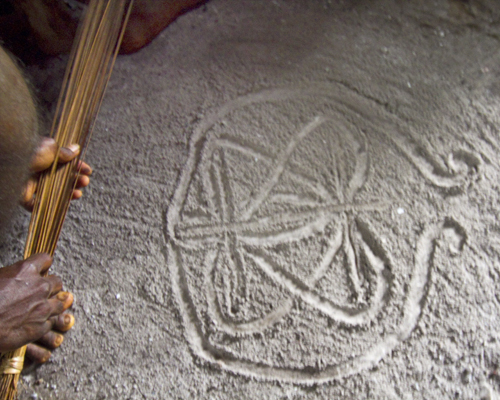Sand painting, the art of drawing mostly symbolic symbols, usually with a single finger, in dirt or sand or ashes, has been practiced on just about every continent for thousands of years. Southwestern Native American (mostly the Navajo) use naturally colored sand as well as corn meal, flower pollen, and powdered roots and bark, to make ritualistic paintings on the ground of a hogan, their sacred lodges that serve much the same function as the nakamal to the ni-Vans in Vanuatu. Tibetan monks compose mandalas of colored powders as a teaching tool and metaphor for the impermanence of life since the drawing, which may take several days to finish, is destroyed almost immediately after completion. Indigenous Australian Aborigine have been practicing sand painting for thousands of years as a way to record history and tell stories.
And here in Vanuatu, it’s also an important part of the culture. As Stephen Zagala has written in his research on Vanuatu sand drawing, “This unique tradition essentially involves tracing geometric figures in dust, sand or ashes. Each design is considered to be a type of maze, and the line of the drawing is traced as a largely uninterrupted path. To give credit to the intellectual sophistication of this practice, it is perhaps more accurate to describe sand drawing as an indigeous form of ‘writing’ rather than ‘drawing.’ In fact, the indigenous words for sand drawing (uli, naites, ghir, rolu, nana, ulan, etc.) are the same words used to describe European writing. In this respect, it is important to realize that sand drawings are much more than simple pictures or decorative patterns.”
After drinking our kava in the Vil-Vil nakamal, a young man spread a bowl of ash onto the dirt floor of the long house, smoothed it with a brush made of reeds, and then quickly, using just his index finger, began drawing elaborate designs, first of a turtle and then of a butterfly. They weren’t as complex or as artistic as I’ve seen, but, in their hieroglyphic simplicity were beautiful none-the-less. The turtle in Melanesian culture often represents steadfastness and long life while the butterfly is a symbol of fertility and death-and-rebirth mythology. I don’t know, maybe I’m over-thinking this, but when I looked at the butterfly the villager had drawn in the ashes of the cold fire, the first thing I saw was the ancient symbol for infinity—sort of a figure 8 on its side. But maybe that’s just me.
Anyway, take a look at this video of a turtle sand drawing in Vanuatu and tell me this isn’t based on a series of infinity signs.
Tags: Vanuatu


Recent Comments